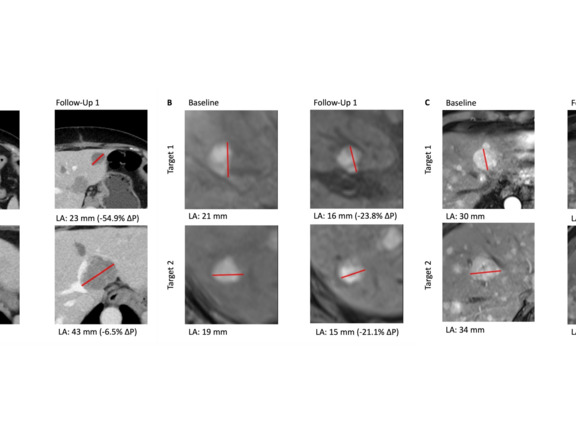A study[1] conducted by researchers at University Hospital Tuebingen retrospectively compared the efficacy of two liver-targeted therapies, Transarterial Radioembolization (SIRT) and Chemosaturation-Percutaneous Hepatic Perfusion (CS-PHP), in patients with uveal melanoma and liver metastases.
Uveal melanoma, though rare, presents a significant medical challenge, particularly when it metastasizes to the liver. Liver-dominant metastasis is a common feature of this disease, and despite the availability of various treatment options, patients often face early mortality.
SIRT, involving the targeted delivery of radiation-emitting microspheres into liver arteries, and CS-PHP, which employs chemosaturation to treat the liver with melphalan, were administered to 62 patients between December 2013 and February 2020. Of these, 34 patients received SIRT, comprising 41 treatment cycles, and 28 patients received CS-PHP, with 56 treatment cycles administered in total.
mint Lesion™ was used to assess the treatment efficacy in line with the Response Evaluation Criteria in Solid Tumors (RECIST 1.1). The study observed that the disease control rate, which includes Complete Response (CR), Partial Response (PR), and Stable Disease (SD), was 18% for SIRT and 30% for CS-PHP.
The study also assessed two critical survival metrics: progression-free survival (PFS) and overall survival (OS). The median PFS for SIRT was 127.5 days, while CS-PHP demonstrated a considerably longer median PFS of 408.5 days. However, the analysis indicated that the difference in PFS between the two treatments was not statistically significant.
In contrast, when it came to overall survival (OS) after treatment, the results showed a significant difference. The median OS after SIRT was 300.5 days, whereas the median OS after CS-PHP was notably longer at 516 days, and this difference was statistically significant. These results suggest that patients treated with CS-PHP experienced a significantly longer overall survival compared to those treated with SIRT.
"In our patient cohort, patients treated with CS-PHP showed a significantly longer OS than patients treated with SIRT. CS-PHP might therefore be preferable for patients with liver-dominant metastatic uveal melanoma”, declared the authors.
These findings emphasize the importance of exploring and optimizing liver-targeted treatment strategies and underline the need for further prospective randomized trials to better understand and address the challenges of this condition.
[1] Kolb, M.; Forschner, A.; Artzner, C.; Grözinger, G.; Said, I.; Dittmann, H.; Seith, F. Selective Internal Radiotherapy (SIRT) and Chemosaturation Percutaneous Hepatic Perfusion (CS-PHP) for Metastasized Uveal Melanoma: A Retrospective Comparative Study. Cancers 2023



